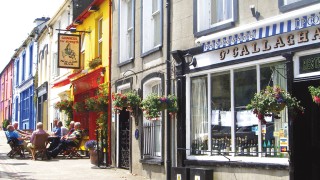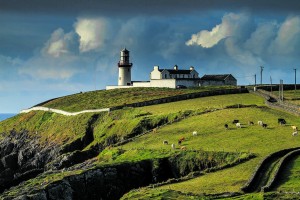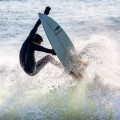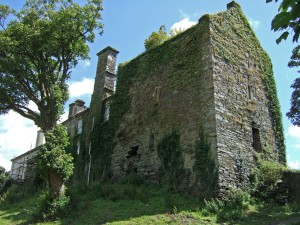
Rosscarbery
Rosscarbery is an attractive village at the edge of the N71, whose skyline is dominated by the historic St. Fachtna’s Cathedral. It has an attractively laid-out square with nicely decorated buildings, which gets busy in summer when crowds flock to nearby beaches such as Owenahincha and The Warren.

Directions
Located on the N71, 65km west of Cork city, 13km from Clonakilty.
Rosscarbery is rich in history and has been home to famous and distinguished people over the years, from St. Fachtna back in the 6th century, to the very famous O’Donovan Rossa, Michael Collins, and Tom Barry in more recent years.
The village cente offers a lively pub scene with live music every weekend as well as some top class restaurants in the charming square with their traditional shop and pub fronts. A traditional farmers market with local food produce is held in the square every Saturday morning.
Calm and tranquil are two words that are very appropriate when describing this haven of beauty. The coastline provides many scenic walks from a simple stroll along the sandy beaches to a hike along the cliff walks. The surrounding region is endlessly entertaining for day and evening pursuits.
The Warren blue flag beach is a popular swimming resort. Here also are two pitch and putt courses and tennis courts adjacent to the sand dunes situated on the shores of Rosscarbery Bay. For those who want to explore further into the Atlantic than is possible from the local beaches, the area offers deep sea fishing trips as well as whale and dolphin watching.
If you prefer to stay on dry land, Rosscarbery is a sanctuary for bird watching – of particular interest are the large flocks of Lapwing and Golden Plover which winter here.
Rosscarbery is host to two annual festivals, the Festival by the Sea which is held over the June bank Holiday and the Family Festival which is held in August. Both of these events have a wide selelection of activites for young and old. The village has very busy periods with its many festivals but whatever the time of year there always seems to be enough parking and a soothing sense of calm about the place.
Visit www.rosscarbery.ie for information on events.
Discover the Locality
History
Rosscarbery grew up around a monastery which was established by St. Fachtna in the latter half of the sixth century. It may seem strange that a village as small as Rosscarbery could have a Cathedral, but the history of the place will reveal why this is so. The Cathedral is dedicated to St Fachtna, disciple of St Finbarr, who is accredited with bringing Christianity to the area in the 6th Century. St Fachtna founded a settlement near an ancient sacred site at Bononagh, just north of Rosscarbery, where an impressive stone circle still stands.
Legend has it that St Fachtna left his bible behind at that spot one day, and when he returned to look for it, he found a shrine had been built over the bible. The area has been known ever since as Teampaillin Fachtna, the shrine of St Fachtna, a spot high on a hill opposite the turning for Owenahincha, commanding fine views out to sea. St Fachtna’s early Christian church flourished and became a centre of learning to which pilgrims came from all over Europe
Rosscarbery survived as the most important village in the region until well into the 19th Century when it was the centre of the local linen trade and known as Ros O gCairbre, meaning ‘the wood of the Carberies’.

Galley Head
The Galley Head is a headland and lighthouse outside of Rosscarbery. Galley Head Lighthouse station is situated on the Galley Head or Dundeady headland in the very heart of West Cork at about 130 feet above sea level, overlooking St George’s Channel and two magnificent beaches, Red strand to the East and the Long Strand to the West. The headland is cut off from the mainland by the ancient walls of the old Norman stronghold of Dun Deidi, an important fortress of the local O’Cowhig Clan.
The station was built in 1875, during the heyday of lighthouse building, and within twenty years of its closest neighbours at Old Head of Kinsale and Fastnet. Lightkeepers who lived here would have witnessed the tragic loss of the Lusitania in 1915, and sighted a German ship carrying arms in disguise as a Norwegian steam being pursued up the channel by British destroyers a year later.
The Galley Head and the Fastnet have the distinction of being two of the most powerful lighthouses in Europe. The lighthouse displays an unusual landward arc of light because, it is said, the Sultan of Turkey asked to be able to see it from Castlefreke nearby on his visit there. The castle, abandoned in 1952 can be seen from Galley as a Gothic ruin.
Castle Salem
Castle Salem is a fortified house near Rosscarbery. The castle was home to the Morris family from around 1660 until the early 1800s, and was bought by the Daly family in 1895 – descendants of whom now run it as a guest house.
The ancient Castle of Benduff, now called Castle Salem, is situated about a mile to the north-west of Rosscarbery, in the bosom of a secluded valley shut in by hills and at one time by a dense plantation of trees. It thus differed from the generality of the feudal strong-holds of old which were either perched on a rocky eminence or surmounted the summit of some rising’ ground. But the sheltered and isolated position of this castle probably protected it from external danger.
Originally a strong structure, the Castle was built in the usual style of the Norman fortresses which studded Ireland during the Middle Ages, distinguished for their square central keep or tower, with thick massive walls and loop holes for the use of arms as well as the admission of light, to which were generally attached side buildings furnished with bastions, and strong outer walls enclosing the entire foundation — these latter being sometimes provided with covered ways. The castle has three internal arches; its walls 11 feet thick, with passages and recesses, and the usual stone stairway. It was originally about 70 feet high until William Morris took the top off, and put on it a slated roof.
The lands of Knocknamadogue with the Castle of Benduff had been the property of Florence McCarthy, a Roman Catholic rebel whose estates were forfeited to Oliver Cromwell. Captain William Morris (abt. 1620–1680) was given over 1500 acres of land, including the castle and he changed the name to Castlesalem. This was in around 1660. The land was formally granted under the act of settlement in 1678.
William Morris despite having been a Cromwellian soldier became a Quaker in 1656 and was an active member of the emerging Friends community in Ireland. Like many of the early Friends, William was to suffer for his beliefs and was imprisoned on a number of occasions.
One of the most widely known Quakers is William Penn (1644–1718), founder of Pennsylvania. As a close friend of William Morris he was often at Castlesalem, particularly in the early months of 1670.
The Morris family still lived in the castle at the beginning of the 19th century but it was bought by Patrick Daly in 1895 and three generations of the Daly family have now farmed the land. Under the stewardship of Michael and Margaret Daly and their family the Castle tower has been partially restored. It is still a working farm and offers bed and breakfast as well as tours. Head west towards Skibbereen for 2km, then take the turning right –Castle Salem is 2km further on.
Things to do
Rosscarbery is the perfect location for activities, both land and water based.
Fishing & Angling
Rosscarbery offers the ideal base for some of Ireland’s most versatile fishing, with many great shore marks within easy reach. From the anglers’ point of view, Rosscarbery is the jewel in the crown that is West Cork. Graham O’Donnell of Clon Tackle & Leisure, Clonakilty offers some tips.
Whatever the weather, Rosscarbery provides a choice of venues from which the angler can always fish. The lagoon, which is separated from the tidal estuary by the main N71 road, offers some of the biggest grey mullet in Ireland to those who wish to take up the challenge of landing them! For those in pursuit of Atlantic Sea Trout, these can also be caught in the estuary and the lagoon. (A State Licence must be purchased before fishing for Sea Trout and Salmon). Wild Brown Trout, Eels and some other species are also possible from this location.
Just the other side of the N71, opposite the Celtic Ross Hotel, is the estuary. Here you will see the Oyster trestles. From this area the angler can also fish for the huge mullet which can be clearly seen, as well as Sea Trout, Flounder, Dabs and the occasional Plaice.
Head down the Pier road past the coastguard cottage, and you will be able to fish the channel. Further down, apart from the species already mentioned, it is possible to catch our much loved Sea Bass and Gilthead Bream. Dogfish, Pollack and Coalfish are other species which frequent the area.
Carry on down the Pier Road and before you know it, you are on the Pier itself. From here, good fishing is assured but when the mackerel are in, you had better be quick to land them. The reason is that there are far better fish catchers than you or I in residence here. Namely, the Seals!
There is good fishing to be had from the rocks just beyond the pier, but places will be limited, so the first few rods to be there will enjoy good sport. Opposite the pier is The Warren Strand. This is an excellent shore mark, with great parking facilities almost on the beach.
Within a short driving distance, there are numerous marks to be fished. The Long Strand, Ownahincha and the Red Strand, to name but a few.
During the summer months, tackle can be purchased from O’Brien’s Bar, The Square, Rosscarbery. For all your fishing tackle, bait and advice, pay a visit to West Cork’s premier tackle shop: Clontackle & Leisure, 2 Pearse Street, Clonakilty. Telephone 023 8835580.
Swimming
The Warren is a small, rural sandy beach backed by dunes and located at the mouth of Rosscarbery river. It is accessed by turning off the N71 towards the coast at Warren Cross, just before you cross the causeway to Rosscarbery village. The area around the beach has been designated as a Natural Heritage Area and the beach itself has achieved Blue Flag status.
Rosscarbery Estuary ia a sea inlet fed by small rivers from the north and north-west. The estuary supports a variety of shorebirds. This beach is lifeguard patrolled at weekends during the bathing season (lifeguard times are displayed on the information noticeboard on the beach).
Wildlife & Bird Watching
Rosscarbery hosts a wonderful diversity of wild life. The town stands above a large lagoon that was once a part of the tidal estuary. The lagoon is large and shallow and is a fine wintering place for species such as the red breasted merganser. Otters are often seen here. Rosscarbery harbours a large indiginous population of mute swan but sometimes whooper swans will use the lagoon as a resting spot on their migration.
Across the causeway there is a road which winds down the eastern side of the estuary where clumps of common rush, vetch, dog daisy and many other wild flowers grow along the roadside. It terminates at the Warren Strand, the dunes and the sea.
This is a very important area for birds, plants and insects. The dunes, which are in themselves a rare feature of our coastline (accounting for only 2% of the total land cover of Ireland) support a rich variety of plant and insect life. The more common species of dune plant-life would include the marram grasses, lady’s bedstraw, birds-foot trefoil, sea holly, sea spurge, sea bindweed and burnet rose.
However, amongst the rarer species of plant found growing on the Warren dunes are the sea pea, the bee orchid and the pyramidal orchid. Both the sea pea and the bee orchid are very rare.
The bird life includes sky lark, meadow pipit and stonechat (all of which nest in this area). In the autumn there are often wheatear feeding on the greens of the pitch and putt course. The families of chough also enjoy these closely-mown areas. There is an ancient heronry in the tall trees behind the Warren and every autumn and winter, snipe can be seen in the wetland area between the Strand road and the pitch and putt course. The kestrel also nests in the vicinity.
Indiginous grey heron, little egret, kingfisher, oystercatcher, red shank, greenshank, mallard and mute swan can be seen all the year round. Alongside these there are grey crows (hooded crows), rooks and jackdaws. The grey crows have developed the habit of breaking shellfish by dropping them from a height onto the road.
At the end of this road is Rosscarbery Pier and the sea. There are steps which lead up from the pier and onto the western headland with its rugged cliffs and panoramic view of both the bay and the ocean.Dolphins and whales can be sighted from this headland: Harbour porpoise, bottlenose, common and Risso’s dolphin. Minke, fin and humpback whale. When conditions are favourable, basking sharks can also be seen from this vantage point. Sightings of sun fish and leatherback turtles have been recorded and the grey seal is prevalent.
Rosscarbery offers the bird watcher, the botanist, the entomolgist and the general lover of nature some rare and wonderful opportunities to see and appreciate, not just the species mentioned but also many others, in their beautiful and natural surroundings.
Walking
Rosscarbery is well geared towards visitors who like to walk as it caters for all tastes, from a short stroll around the lagoon on the flat, to the more strenuous woodland walk involving steep climbs, lasting several hours. Long Strand, on Rosscarbery Bay, is a long stretch of sand to have a good walk on, with spectacular views.
See Clonakilty & Area Walks and under the Walking section.




